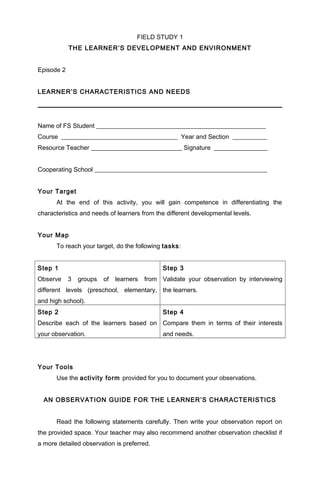Field study 1(episode 2)
- 1. FIELD STUDY 1 THE LEARNERâS DEVELOPMENT AND ENVIRONMENT Episode 2 LEARNERâS CHARACTERISTICS AND NEEDS Name of FS Student ______________________________________________________ Course _____________________________________ Year and Section ___________ Resource Teacher _____________________________ Signature _________________ Cooperating School _______________________________________________________ Your Target At the end of this activity, you will gain competence in differentiating the characteristics and needs of learners from the different developmental levels. Your Map To reach your target, do the following tasks: Step 1 Observe 3 groups of learners from different levels (preschool, elementary, and high school). Step 3 Validate your observation by interviewing the learners. Step 2 Describe each of the learners based on your observation. Step 4 Compare them in terms of their interests and needs. Your Tools Use the activity form provided for you to document your observations. AN OBSERVATION GUIDE FOR THE LEARNERâS CHARACTERISTICS Read the following statements carefully. Then write your observation report on the provided space. Your teacher may also recommend another observation checklist if a more detailed observation is preferred.
- 2. Physical 1. Observe their gross motor skills. How they carry themselves. How they move, walk, run go up the stairs, etc. 2. Are gross movements clumsy or deliberate/smooth? 3. How about their fine motor skills? Writing, drawing, etc. Social 1. Describe how they interact with teachers and other adults. 2. Note how they also interact with peers. What do they talk about? What are their concerns? Emotional 1. Describe the emotional disposition or temperament of the learners. (happy, sad, easily cries, mood-shifts) 2. How do they express their wants/needs? Can they wait? 3. How do they handle frustrations? 4. Describe their level of confidence as shown in their behavior. Are they self- conscious? Cognitive 1. Describe their ability to use words to communicate their ideas. Note their language proficiency. 2. Describe how they figure out things. Do they comprehend easily? Look for evidence of their thinking skills. 3. Were their opportunities for problem solving? Describe how did they show problem solving abilities. LEARNERâS DEVELOPMENT MATRIX Record the data you gathered about the learnerâs characteristics and needs in this matrix. This will allow you to compare the characteristics and needs of learners at different levels. The items under each domain are by no means exhaustive. These are just sample indicators. You may add other aspects which you may have observed. Development Domain Preschooler (Indicate age range of children observed:_________ Elementary (Indicate age range of children observed:_________ Highschool Indicate age range of children observed: _______ Physical
- 3. Gross-motor skills Fine-motor skills Self-help skills Others Social Interaction with Teachers Interaction with classmates/friend s Interests Others Emotional Moods and temperament, expression of feelings Emotional independence Others Cognitive Communication Skills Thinking Skills Problem-solving Others Your Analysis Write the most salient developmental characteristics of the learners you observed. Based on these characteristics, think of implications for the teacher.
- 4. Example: Level Salient Characteristics Observed Implications to the Teaching-Learning Process Preschool Age range of Learners Observed __________ Preschoolers like to move around a lot. âĒ Therefore, the teacher should remember to use music and movement activities not just in PE but in all subject areas. âĒ Therefore, teachers should not expect preschoolers to stay seated for a long period of time. Write your own observation here. Level Salient Characteristics Observed Implications to the Teaching-Learning Process Preschool Age range of learners observed ___________ Elementary Age range of learners observed ___________ Highschool Age range of learners observed ___________
- 5. Your Reflections 1. While you were observing the learners, What did you recall in your own experiences when you were their age? What similarities or differences do you have with the learners you observed? 2. Think of a teacher you cannot forget for positive or negative reasons. How did she/he help or not help you with your needs (physical, emotional, social, cognitive)? How did it affect you? 3. Which is your favorite theory of development? How can this guide you as a future teacher? 4. Share your insights here.
- 6. Your Reflections 1. While you were observing the learners, What did you recall in your own experiences when you were their age? What similarities or differences do you have with the learners you observed? 2. Think of a teacher you cannot forget for positive or negative reasons. How did she/he help or not help you with your needs (physical, emotional, social, cognitive)? How did it affect you? 3. Which is your favorite theory of development? How can this guide you as a future teacher? 4. Share your insights here.






